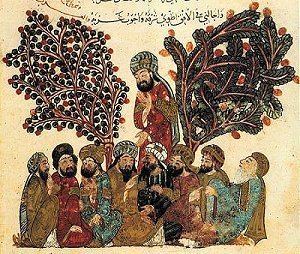 | ||
Maqamat Badi' al-Zaman al-Hamadhani (Arabic مقامات بديع الزمان الهمذاني), are an Arabic collection from the 9th century of 400 episodic stories, roughly 52 of which have survived. They 'are characterized by the alternation of rhymed prose (sajʿ) and poetry. They are narrated from the point of view of a fictitious character, 'very likely a traveling merchant who has money and time', ʿĪsā ibn Hishām, about the adventures of an eloquent beggar named Abū al-Fatḥ al-Iskandarī'. The Maqamat are also known for their intertextuality and narrative construction.
According to Ailin Qian,
the core of the Hamadhānian maqāmah is dialogue, and al-Hamadhānī, by using techniques such as isnād and framing, simulated some kind of public presentation. Al-Hamadhānī’s efforts to preserve the characteristics of oral performance in his maqāmāt## played a great role in creating their prosimetric style.
A century later, these maqamat inspired the maqamat of Al-Hariri of Basra, which in turn inspired the Hebrew Tahkemoni.
